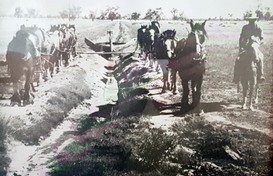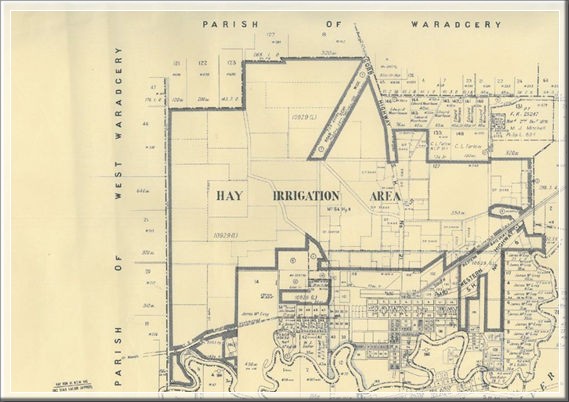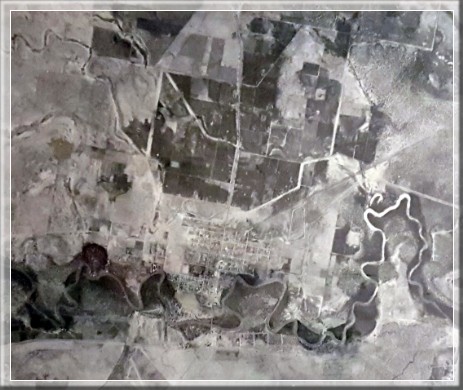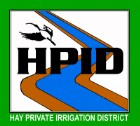The History of the Hay Private Irrigation District
The Hay Irrigation Act was passed on 31st March 1892 providing for construction of the Irrigation Area and the raising of loans. The Council of the Municipal District of Hay was authorised to administer the Act, and the Irrigation Area covered 8,032 hectares on both sides of the Murrumbidgee River set aside from the Hay Temporary Common. (Figure 1)In May 1892 a loan was carefully assessed by a Mr McKinney, Chief Engineer for Water Conservation and Drainage, after favourable observations relating to soil type and elevation. He nominated a suitable site for the river extraction point that allowed for water to be gravity fed through an open channel system after being pumped to the level of the river bank.A report examining the proposal by J.L. Thompson, Principal of The Hawkesbury Agricultural College indicated that the area under irrigation was ideal for the production of olives, figs, vines, citrus, peaches and apricots and admirably suited to the processing of dried fruit given the hot dry climate. Upon establishment of the scheme, early experience proved otherwise as the area was found mostly suited to fodder production.By May 1893, part of the Irrigation Area was subdivided into 2 hectare blocks of which 162 hectares were immediately applied for, making it the oldest irrigation district in NSW and the third oldest in Australia (Map 3). The Trust proceeded to acquire and install a pumping plant that utilised second hand equipment sited on Lots 1, 2 and 3 situated between Murray St and the railway line. This was not the location recommended by McKinney. The pumping plant was constructed with a badly designed timber and iron flume that was quickly wrecked by a storm. A holding reservoir was also constructed nearby. The reservoir proved a disaster as it leaked badly and lost much water to evaporation and was soon abandoned. The replacement infrastructure consisted of some 1,700 metres of delivery pipeline. It is described as consisting of 100 metres of 24 inch very thin walled wrought iron suction pipe followed by 40 metres of delivery pipe to a small cylindrical receiver from which it gravitated 1,550 metres through 26 inch steel pipes to a square brick chamber forming the head of the main irrigation channel. The stove pipe joints were plagued by leaks requiring constant patching causing much trouble and expense. The equipment was formerly used as a portion of the Sydney Water Supply from Crown St to Paddington and not designed for the lifting of water for the Hay Irrigation District of almost 12 metres.
 Figure 1 - Hay Irrigation Trust pump site in the late 1800's |  Early construction of the stage |  Construction of one of the first channels |

Map 3 - First Hay Irrigation
Area Subdivision (1897)
The second hand wood-fired steam driven pumping engine was of the horizontal, compound, rotary, jet-condensing type driving two horizontal piston pumps from a flywheel. The pumps were serviced by two multi-tubular, return-tubed, side-flued boilers purchased second hand from the cable tram works in North Sydney.In 1896 a new Trust was appointed by an amending Act of Parliament to complete the Hay Irrigation scheme. It was administered by the Department of Lands, and its area was reduced to 1781 hectares in what constituted a rescue package, as the departure from McKinney’s recommendations had left the scheme floundering. Over the coming years the irrigation system proved inefficient, unreliable and economically unsustainable being further burdened by an inefficient channel network, the failed construction of a storage reservoir and poor irrigation practices and distribution systems on-farm.Fodder production supported dairying activities and a butter factory was established at Hay producing 2 tons of butter per week supplied from locally produced cream. The irrigation system consisted of 2.6 km of main channel and 9 km of laterals. Up to this time water was distributed in a haphazard fashion however, this changed with the introduction of newly developed inferential meters.The heavy cost of pumping with the old fashioned plant depleted the Trusts revenue and maintenance costs on the pipeline were very high.In 1908 the control of the Hay Irrigation Act passed from the Lands Department to the Agricultural Department, along with the debt and liabilities. In 1909 the Government again came to the financial rescue of the scheme. An upgrade of the pump and delivery pipeline was undertaken however, the site of the pumping plant remained at the less efficient site due to budgetary constraints.In 1911, the steam plant replaced the more expensive timber fuel with coal to fire the boilers and the Government eventually agreed to relocate the pumping station to a more suitable site. By November 1911 tenders had been awarded for the construction of new belt driven centrifugal pumps powered by a new producer plant and suction gas engine.The records indicate that around 1912, two Hornsby suction gas engines fuelled by coking coal powering two 10 inch pumps, were installed at a new site, the current day site on the river located between Lots 9 and 10 off the Midwestern Highway. The new site followed the McKinney recommendations in that water was lifted directly from the river into an open channel relying on gravity for delivery.The new suction gas engine pumping system proved to be sustainable but for administrative purposes relating to funding arrangements, the Trust was dissolved in 1912 and came under control of the Minister of Agriculture who placed it in the charge of a Superintendent until June 1913. After this time the trust came under control of the Water Conservation and Irrigation Commission.Sometime later a single cylinder 75 HP Ruston Hornsby diesel engine was purchased and installed on the river bank to supplement the water supply pumped by the suction gas plant. Later again the Ruston Hornsby engine was moved forward to its final position (Figure 2 ) and a 3 cylinder 60 HP Davy Paxman diesel engine was installed alongside the Ruston Hornsby ( Figure 3 ). The two 10” suction lines from the suction gas pumps were joined together and connected to a 16” Clyde pump driven by the Davy Paxman engine; this installation marked the end of the suction gas era. During World War 2 a 3 cylinder 125 HP Petter diesel engine (Figure 2) and a 12” Briton pump were installed in 1942 to supplement the water supply to the POW camps.The new diesel powered plant operated successfully for many years, although its operation was marred by two pump-house fires. The last fire resulted in the complete destruction of the old pump site. It was fortunate that at the time the last fire occurred, the new electric pump station was almost complete and was only weeks away from being commissioned.The boundaries of the irrigation area were amended in 1919 and 1930 and further enlarged in 1938. In 1958 major new works were undertaken to upgrade the scheme to cope with the proposed enlargement of the Hay Irrigation Area (Map 4) with the installation of new pumps and pump-house. The pumping system was converted to electrical power. Surveys and works were also completed for channel enlargement and extension to also allow enlargement of farms with holdings based on perpetual leasehold tenure.
 Figure 1 - Hay Irrigation Trust pump site in the late 1800's |  Figure 2 - Rustin and Hornsby engines |  Figure 3 - Davey Paxman diesel pump |

Map 4 - Hay Irrigation Area boundaries (1958)
In 2008 the Hay Private Irrigation District improved the facilities offered to members with the installation of a filtered stock and domestic pressurized pipeline.
These facilities were once again improved with the modernization of the whole scheme in 2017 by the completion of a fully enclosed, underground pipeline that allows its members to order water when they require it.
This district now delivers water to over 150 outlets throughout the irrigation district and surrounding areas.


Above and to left: Arial views of the irrigation areas, north of the Hay township, that is serviced by the Hay Private Irrigation District


